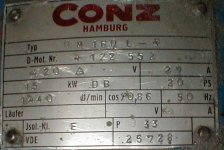gbradley
Lifetime Supporting Member
Heres the situation.
I just received a hydraulic press from England.
We plan to set it up and run it here.
It has a 420 Volt motor (50 HZ)and what I now believe is a 110V Control circuit.
I thought that I had a replacement motor, but upon further inspection found out that the 20 HP motor is double ended. (a shaft coes out of both sides) so I don't have another motor.
Replacing this motor is going to be a royal pain.
Perhaps DickV or somebody else knows.
Is it feasable to purchase a bucking transformer, and knock down my voltage from 480V to the 420V?
Do they make some kind of VFD/transformer combo to knock down the frequency at the same time?
Attached is a picture of the motor Nameplate.
Any comments are appreciated

I just received a hydraulic press from England.
We plan to set it up and run it here.
It has a 420 Volt motor (50 HZ)and what I now believe is a 110V Control circuit.
I thought that I had a replacement motor, but upon further inspection found out that the 20 HP motor is double ended. (a shaft coes out of both sides) so I don't have another motor.
Replacing this motor is going to be a royal pain.
Perhaps DickV or somebody else knows.
Is it feasable to purchase a bucking transformer, and knock down my voltage from 480V to the 420V?
Do they make some kind of VFD/transformer combo to knock down the frequency at the same time?
Attached is a picture of the motor Nameplate.
Any comments are appreciated

Last edited:




